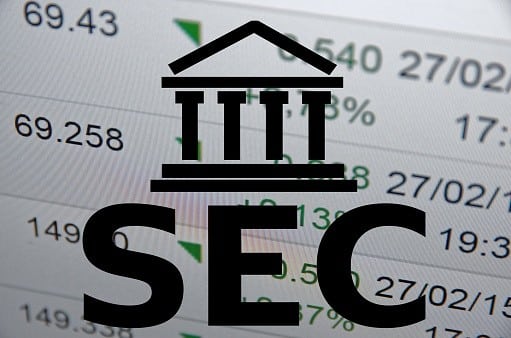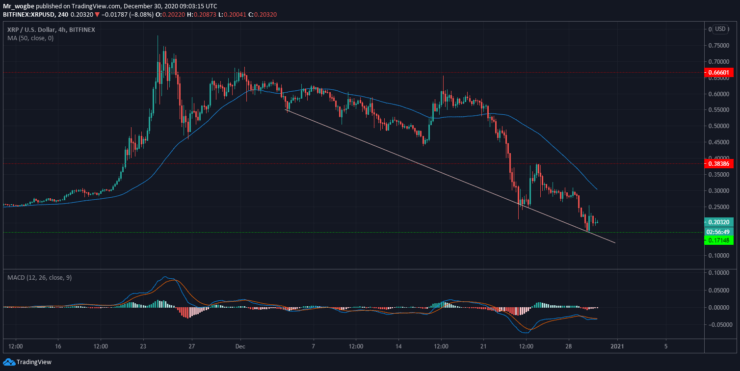The past few days have been a very heart-wrenching experience for Ripple (XRP), which has seen the third-largest cryptocurrency shave off close to 60% from its value. Things came crashing for the cryptocurrency following a recent lawsuit by the SEC.
In this article, we will be taking a deep dive into the SEC’s lawsuit against XRP, the nature of XRP, and price reactions and predictions relating to the lawsuit-induced crash.
The SEC’s Cryptocurrency-Related Lawsuits in 2020
The US Securities and Exchange Commission (US SEC) has been tough on cryptocurrencies this year. Earlier this year (sometime in March), the Commission won a worldwide injunction against Telegram’s stablecoin (GRAM) issuance, decimating several years of research and innovative progress, even in the absence of fraud allegations.
8cap - Buy and Invest in Assets

- Minimum deposit of just 250 USD to get lifetime access to all the VIP channels
- Buy over 2,400 stocks at 0% commission
- Trade thousands of CFDs
- Deposit funds with a debit/credit card, Paypal, or bank transfer
- Perfect for newbie traders and heavily regulated

Fast-forward to December 22, the SEC decided to go for another high-profile case. The Commission filed its lawsuit in the above-mentioned district against Ripple Labs and its previous and present Chief Executive Officers (CEO), Christian Larsen and Bradly Garlinghouse, respectively, for raising about $1.38 billion through a sale of XRP since 2013.
The immediate effect of this lawsuit was brutal on XRP, which dropped by about 25% just 24 hours after the suit was filed.

The Complaint
The Securities and Exchange Commission announced on the 22nd of December that it had filed an action against Ripple Labs and two of its excos, who the Commission deems as significant security holders, for allegedly raising over $1.3 billion through an unregistered, ongoing digital assets securities offering.
According to the SEC’s complaint, Ripple; Christian Larsen, the company’s co-founder, executive chairman of its board, and former CEO; and Bradley Garlinghouse, the company’s current CEO, crowdfunded capital to fund the firm’s operations. The suit alleges that Ripple’s crowdfunding activity began in 2013, from the sale of XRP in unregistered security offerings to investors in the US and across the globe. The complaint also alleged that Ripple distributed billions of XRP for non-cash consideration, like labor and market-making operations.
The suit also alleges that in addition to developing, promoting, and selling XRP which is used to fund its operations, Larsen and Garlinghouse also carried out personal ‘under-the-counter’ sales of XRP, amounting to the tune of approximately $600 million. The complaint alleges that the defendants failed to meet the registration requirements per the registration provisions of the federal securities laws, which puts them in a culpable situation.
Stephanie Avakian, the Director of the SEC’s Enforcement Division, noted that “issuers seeking the benefits of a public offering, including access to retail investors, broad distribution and a secondary trading market, must comply with the federal securities laws that require registration of offerings unless an exemption from registration applies.” She added that “we allege that Ripple, Larsen, and Garlinghouse failed to register their ongoing offer and sale of billions of XRP to retail investors, which deprived potential purchasers of adequate disclosures about XRP and Ripple’s business and other important long-standing protections that are fundamental to our robust public market system.”
8cap - Buy and Invest in Assets

- Minimum deposit of just 250 USD to get lifetime access to all the VIP channels
- Buy over 2,400 stocks at 0% commission
- Trade thousands of CFDs
- Deposit funds with a debit/credit card, Paypal, or bank transfer
- Perfect for newbie traders and heavily regulated


The idea behind XRP was developed back in early 2012, after which the company changed its name to Ripple. The XRP Ledger—or otherwise known as the software code—functions as a peer-to-peer database spread across a network of computers (nodes), tasked with recording data about transactions among other requirements. To gain consensus, each server on the network assesses every transaction from a subset of trusted nodes, to prevent fraudulent transactions. The trusted nodes are known as the server’s unique node lost or UNL.
On the XRP network, each server has the liberty to define its own trusted nodes. However, the XRP Ledger requires a healthy level of trusted nodes overlaps chosen by each server. To achieve this, Ripple makes a proposed UNL public.
After the XRP Ledger was finally completed and as it was getting deployed to the designated servers to run it in December 2012, exactly eight years ago, a fixed supply of 100 billion XRP was set and manufactured at a very minimal cost. After the creation, 80 billion XRP tokens were transferred to Ripple, the host company, while the remaining 20 billion tokens were transferred to the founders, including Larsen. This meant that Ripple and its founders controlled all XRP in existence at the time.
These decisions were said to have been executed as a compromise between a fully decentralized peer-to-peer network inspired by Bitcoin (BTC) and a fully centralized network with a single trusted intermediary, just like a traditional financial institution. That said, Bitcoin was never fashioned to be operated in a centralized manner, while XRP was originally designed to be just that considering the initial token distribution. This hybrid approach to blockchain-based digital assets, which was controlled by a central body, sparked unrest in the cryptocurrency community, with many crypto enthusiasts saying that XRP was not a “true” cryptocurrency.
According to the SEC, between 2013 and 2014, Ripple and its founders sought to carve out a market for XRP by demanding that Ripple distribute about 12.5 billion XRP via bounty programs, which saw programmers earn tokens for reporting bugs on XRP Ledger’s code. To further boost the circulation and create a trading market for XRP, Ripple distributed small sums of tokens—typically between 100 and 1,000 XRP per transaction—to anonymous developers and others.
Then, Ripple executed more systematic actions to boost speculative demand and the trading volume for XRP. In 2015, Ripple began a campaign to make XRP a “universal digital asset” for banks and other traditional financial institutions to carry out monetary transfers. According to the SEC, to do this, Ripple needed to have created an active, liquid XRP secondary trading market. This means Ripple expanded its efforts to create a use for XRP while boosting sales of the cryptocurrency in the market.
At this point Ripple Labs, and its subsidiary XRP II LLC, came under investigations by the US Financial Crimes Enforcement Network (FinCEN), acting according to its mandate in the Bank Secrecy Act (BSA). The Northern District in California, in conjunction with the US Attorney’s Office, charged both companies for failing to meet the various stipulated BSA requirements, including not registering with the FinCEN and defaulting on maintaining adequate Anti-Money Laundering (AML) and Know Your Customer (KYC) protocols. The FinCEN asserted that Ripples’ failure to comply with the requirements opened the door for terrorists and money launderers to use XRP maliciously.
However, this case didn’t make it to trial, as Ripple Labs agreed to settle the charges by paying a $700,000 fine and update the company’s operations to meet the required BSA standards. The out-of-court agreement was announced on May 5, 2015. Throughout its investigation, the FinCEN maintained that XRP was a digital currency, which Ripple acceded to and has since updated its protocols to meet BSA requirements.
The SEC complaint noted that from 2014 through the third quarter of 2020, Ripple sold at least 8.8 billion XRP in the market and institutional sales, netting approximately $1.38 billion to finance its activities. Additionally, the complaint asserted that from 2015 through March 2020, while he was the CEO and later chairman of the board at Ripple, Larsen and his wife, Lyna Lam, sold over 1.7 billion XRP to public investors in the cryptocurrency market.
The couple was reported to have made at least $450 million from the sale. Meanwhile, from April 2017 through December 2019, while he was the CEO of Ripple, Garlinghouse sold more than 321 million XRP that he had received from Ripple to public investors in the cryptocurrency market, grossing about $150 million from the sale.
Exchanges Begin Delisting XRP
Following the messy lawsuit against the cryptocurrency giant, many exchanges have begun unlisting or suspending XRP trading on their platforms. Coinbase was the latest exchange to distance themselves from XRP as the suit drags on.
Coinbase listed XRP on its retail-facing platforms in February 2019. However, Coinbase has announced that the cryptocurrency has now been moved to the “limit only” section for now and will be fully suspended on January 19, 2021. Paul Grewal, the Chief Legal Officer at Coinbase, wrote in a blog post that “we will continue to monitor legal developments related to XRP and update our customers as more information becomes available.”
Meanwhile, the exchange has assured that users’ XRP wallets will still be able to receive funds and facilitate withdrawal even after the full suspension. Most notably, Coinbase has confirmed that its platform will still support an upcoming airdrop of Spark tokens to XRP holders. That said, XRP will remain supported by Coinbase Custody and in the self-custodial Coinbase Wallet.
XRP’s price on Coinbase crashed from around $0.24 in the first 20 minutes of the announcement made on December 28. Subsequently, the cryptocurrency has erased more than 60% from its valuation since the SEC lawsuit was announced last week.
Coinbase noted that the reason for dropping XRP as a traded asset on their platform was because, as the Ripple sought to IPO, being a platform that hosts something that’s a security offering—or has the potential to be—would require updating and adding paperwork to make it legal for retail traders to trade.
Coinbase is the largest cryptocurrency exchange to sever its relations with XRP following the SEC’s lawsuit. This development could spur similar actions among other cryptocurrency exchanges.
Bitstamp and OKCoin announced previously that they were suspending XRP trading and deposits for all US customers on the 8th and 4th of January respectively.
Exchanges that continue to offer XRP without registering as a securities exchange with the SEC risk running into problems with the authorities. However, if Ripple wins this case or gets away with minimal punishment, Coinbase and other exchanges are likely to re-list XRP swiftly.
Alex Kruger, a cryptocurrency trader/analyst, put it more eloquently by saying that “crypto exchanges are unregistered with the SEC (by choice, as registering carries on many burdens and increased costs) and thus it is in their best interest to not offer to trade in securities. It is for their protection, not their customers’.”
Gabriel Shapiro, an attorney with Belcher, Smolen & Van Loo LLP, said in a recent interview that the decision to delist XRP by exchanges is a complicated one, considering both financial and legal repercussions.
Our Opinion
Although the ongoing debacle seems dire, we believe that there’s no cause for panic yet. There’s an opportunity here. US-based exchanges delisting XRP was expected, considering that they have a jurisdictional obligation to adhere to the SEC. These exchanges do it for safety reasons.
In December, Japan announced that XRP is not deemed a security offering. The U.K. made the same announcement earlier.
That said, we believe that this SEC probe is temporal and Ripple will most likely end up with a fine at most. The case is believed to be of low merit, considering that the SEC did not quantify XRP as a security offering some years back. Nonetheless, the price of XRP will be seriously affected when more US-based exchanges suspend the cryptocurrency temporarily, but we expect full recovery next year when this all blows over.
That said, “there’s blood on the streets” and it’s currently a good time to position oneself to profit from the situation. However, we can’t say for sure how far this decline will go, but there’s an opportunity here for sure. As always, we wanted to bring the news to you (our readers) as we usually do when we spot a good trading opportunity.

At press time, XRP is now sitting deep within the oversold territory—based on our 4-hour MACD indicator. While wild swings are commonplace in cryptocurrency trading, protracted trends are bound to reverse dramatically. Ripple is currently down -30% over the past 24 hours.
Retail trader data shows that about 94% of traders are net-long, with the ratio of traders long to short standing at 17.3 to 1. However, the number of traders net-long is 5% lower than two days ago and 2.8% lower from last week, while the number of net-short is up 53% from two days ago and 36% higher from last week. This indicates that traders are less net-long than two days ago compared to last week.
Nonetheless, recent changes in trading sentiment suggest that the current XRP price trend could see a sharp reverse higher soon.
Meanwhile, XRP’s erratic volatility began when the news about the Spark token airdrop started spreading among traders. The announcement-induced rally caused the cryptocurrency to snap its multi-year trading range between $0.20 and $0.30 and proceed close to $0.90 across several exchanges.
At this point, traders began placing interest in the crypto, which helped it stabilize around $0.60. However, the news about the SEC lawsuit against Ripple broke and sent the third-largest cryptocurrency on a sharp drop to the $0.20 region once again, where it found fresh demand again. Then, the news of Coinbase suspending XRP trading in the coming week sparked a fresh sell-off, which took the price briefly below the crucial $0.20 support.
That said, speculators expect further downsides in the near-term, citing further delisting by exchanges coupled with plunging liquidity as the major catalysts. Already, some large market-making firms that have worked with Ripple have begun cutting ties with the company, which suggests that liquidity will plunge dramatically soon.
However, at press time, the XRP market has seen a healthy recovery from its recent foray from the $0.17 lows to the $0.21 area. This rebound represents a short-squeeze, although it may not last long. Heavy selling pressure can be seen at the $0.24 level, which appears to be a major growth-hampering factor for the XRP.
Furthermore, one analyst has painted a depressing picture of XRP in the coming weeks, as he makes a price prediction between $0.07 to $0.12. He noted that further exchange delisting, liquidity shortage, and the exit of whales will continue to place pressure on the value of XRP. he said “XRP: IMO the dust will settle in the next few weeks/months somewhere in between .07-.12c. Liquidity will dry up. ODL can’t be used on Bitstamp. More exchanges will halt trading. Larger players will continue to de-risk and get rid of excess inventory. Just the way I see it.”
8cap - Buy and Invest in Assets

- Minimum deposit of just 250 USD to get lifetime access to all the VIP channels
- Buy over 2,400 stocks at 0% commission
- Trade thousands of CFDs
- Deposit funds with a debit/credit card, Paypal, or bank transfer
- Perfect for newbie traders and heavily regulated

Nonetheless, the coming days should make things clear for the next directional trend for XRP, keeping the outcome of this prevailing short-squeeze in mind.
- Broker
- Min Deposit
- Score
- Visit Broker
- Award-winning Cryptocurrency trading platform
- $100 minimum deposit,
- FCA & Cysec regulated
- 20% welcome bonus of upto $10,000
- Minimum deposit $100
- Verify your account before the bonus is credited
- Fund Moneta Markets account with a minimum of $250
- Opt in using the form to claim your 50% deposit bonus
Learn to Trade
Never Miss A Trade Again

Signal Notification
Real-time signal notifications whenever a signal is opened, closes or Updated

Get Alerts
Immediate alerts to your email and mobile phone.

Entry Price Levels
Entry price level for every signal Just choose one of our Top Brokers in the list above to get all this free.




